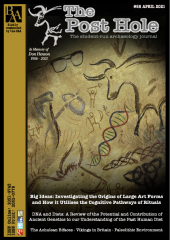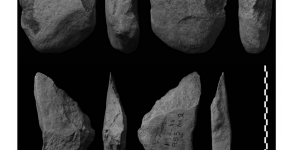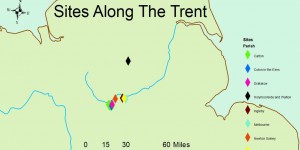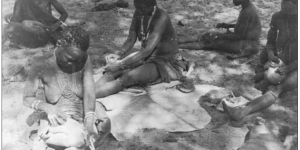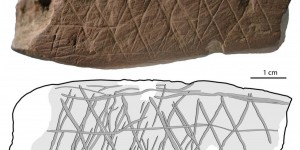Abstract: There is a significant lack of understanding and investigation into the presence of the Vikings in Wales during the early medieval period (c. AD 700 to AD 1000). This article explores some of the evidence of possible interactions between Viking raiders and the native population, hoping to shine a light on a misunderstood aspect of the Viking World.
Introduction
During the Viking raids on the British Isles, Wales was not the united country it is today. Whilst these destructive and bloody raids were taking place across England, Ireland and Scotland, Wales was dealing with internal conflicts, political strife and internecine warfare (Charles 1934). However, the re-examination of historical accounts, newly discovered archaeological evidence, and local oral history, has revealed that the country was subject to the brutality of the Viking raids, albeit perhaps in a very different way from their British neighbours.
The early medieval period in Britian, c. AD 700 – 1000, was a turbulent time for the Welsh territories, even without the raids. Wales was split into several independent kingdoms, each led by its own powerful ruler with their own agenda for their people and territory. This division, stemming from the days of the Celtic tribes, meant there was no united Welsh front against the Viking raiders when they arrived in large numbers during the early medieval period. Figure 1 shows the division of the land during this period.
![Figure 1 ref: A, Lancaster. (nd.) Early Medieval Wales. Available at: viking-5-wales-vikings-on-the-coast.jpg [accessed 17/02]](/sites/theposthole.org/files/styles/medium/public/articles/506/Figure 1 (1).jpg?itok=eOwHYLas)
With this division in the Welsh territories, constantly rife with internal warfare one would expect the Viking raiders to have easily overrun the native Welsh population, raiding freely with little resistance. But according to historical accounts, and the archaeological evidence, this is simply not the case. The Scandinavians had come to Britain with the intent of raiding and looting, and it seems that they were successful in this endeavour to some extent. But another driving factor of these raids, the desire to claim and take land to settle, was seemingly not achieved here. While England, Ireland, and Scotland were being settled and pulled into the Viking Diaspora, or places that the Vikings had migrated to, Wales seems to have been neglected in this movement. And so, the question must be asked, why?
Early Medieval Wales
Whilst the Anglo-Saxon Chronicle (c. 9th century) describes the united efforts of the English to end the Viking terror in their lands, the Welsh Chronicles, (specifically the Annales Cambriae (c. 10th century) which can be seen in Figure 2), detail the sporadic movement of Viking forces around and across Wales. These were relatively unchallenged in comparison to what was happening in England at the time. The divided territories of Wales, and their small sporadic forces, seemed to be no match for the Viking raiders, and yet, Wales and its lands did not fall into the hands of these Scandinavian visitors (Charles 1934). his Viking movement and raiding activity was certainly still as destructive and un-wanted in Wales as it was in England. However, these raiders simply did not meet the same deterring force from the Welsh, that their counterparts in the Anglo-Saxon territories were dealing with (Redknap 2008).
![Figure 2 ref: Dumville, D. (2002) Annales Cambriae, A.D. 682-954: Texts A-C in Parallel. Available at: brut_y_brenhinoedd.jpg [accessed 17/02]](/sites/theposthole.org/files/styles/medium/public/articles/506/Figure 2 (1).jpg?itok=cd65PBUL)
Whilst England and Scotland all but went to war against these Scandinavian invaders, the Welsh territories dealt with the threat as it came, sending small numbers of troops to coastal areas, and attempting to merely deter the raiding activity that was occurring on their shores. Some Welsh kings did manage to unite large forces, and defend their lands from Viking settlement and extensive conflict by utilising the people's terror of this foreign threat (Charles 1934). Two of these rulers are Rhodri ap Merfyn, who ruled between AD 844 and AD 878 (also known as Rhodri the Great), and Hywel Dda (the good), who ruled between AD 900 to AD 950. However, little evidence can be found to suggest that these efforts continued throughout the period, or were being conducted by other Welsh rulers at the time (Redknap 2008). The effort of these kings did appear to result in success on the part of the Welsh. However, as there is little evidence of Viking settlement, or a significant Viking presence in Wales from the early medieval period. But perhaps, a close re-examination of the available evidence, paints a different picture.
Viking Conflict and Raiding
Despite this accepted knowledge of raiding and conflict between Viking forces and the native Welsh, many academics would argue that Wales is simply not relevant when discussing the wide expansive world of the Viking Diaspora (Jesch 2015). When presented with a map of ‘Viking Britain’, Wales is often left blank and grey, as if it is simply not relevant. But, as previously discussed, the country received its fair share of raiding and Scandinavian activity during the early medieval period. So why is it not considered a part of the Viking World?
For several decades, there has been a consensus within the world of Viking academia, that the country of Wales was not settled, or even significantly raided by the Vikings during the early medieval period. However, there are several pieces of evidence that strongly contradict this interpretation, placing Wales within the expansive and eclectic world of the Viking Diaspora. For example, sagas created in Iceland in the 11th century, such as the well-known and much loved Njal’s Saga (Magnusson and Palsson, 1960), has key characters heading to Wales to raid. This can also be seen in Orkneyinga Saga (Palsson and Edwards, 1978), which was written around the same time. These Old Norse texts call the country ‘Bretland’, and often describe it as one of the ‘usual’ sites to send raiding parties during the period (Redknap 2008). Whilst these texts cannot be accepted as historic fact, they do create a fascinating narrative around this topic, even going so far to describe Norse settlement in Wales, and marriages between Scandinavians and the native population (Charles 1934). An example is described in The Saga of the Jómsvíkings (Hollander, 1955. English translation below by author) from c. 930:
“… Og þá er þetta er tíðenda, þá ræður fyrir Bretlandi jarl sá er Stefnir hét. Hann átti sér dótturþá er Ólöf hét. Hún var vitur kona og vinsæl, og var það góður kostur, svo að stórum bar. Það er sagt, að Pálnatóki kömur þar við land skipum sínum og ætlaði að herja á ríki Stefnis jarls. Og er það spyrst, þá tekur Ólöf það til ráðs með Birni hinum brezka …"
“… At that time a jarl ruled in Bretland whose name was Stefnir. He had a beloved daughter named Álof. She was wise and well loved. Palnatóki landed there with his fleet and intended to attack Stefnir's land. But when they learned of that, Álof and her counsellor, Björn inn breski (the Welshman) …”
But it is not only literature evidence that paints a picture of a strong Viking presence in Wales during this period. Archaeological material, including Viking graves, as well as place names that derive clearly from Old Norse terminology, can also be found up and down the country (Loyn 1976). In fact, some of the most populated towns and cities in Wales, such as Cardiff and Swansea, have Old Norse names, based on the tradition of naming places after a Scandinavian ruler; such as ‘Sweyns-ey’, or ’Swansea’, meaning Sweyn’s island (Holmes and Lilley nd). Other places in Wales with Old Norse names congregate around coastal areas, such as Caldey Island (West Wales), Freystrop (West Wales), Skokholm Island (West Wales) and Anglesey (North Wales). This could be seen to represent the nature of the Viking presence in Wales, a group with superior seafaring tactics and knowledge gravitating towards coastal areas for raiding. An example of archaeological evidence that highlights the presence of Vikings in these coastal areas can be seen in Figure 3, which shows an elaborately decorated sword hilt that was discovered in Fishguard, West Wales.
![Figure 3 ref: Amgueddfa Cymru - National Museum Wales (1992) Viking copper alloy sword guard. Available at: https://museum.wales/collections/online/object/d34b155c-3661-3323-841c-53aeea42623b/?field0=string&value0=Llychlynwyr&field1=with_images&value1=on&index=0 [accessed 17/02]](/sites/theposthole.org/files/styles/medium/public/articles/506/Figure 3.jpeg?itok=CqADOUpK)
The massacre of the Danes at the Battle of Buttington (AD 893), referred to in the Anglo-Saxon Chronicles, is also one of the key pieces of evidence when considering the Viking presence in Wales. This battle was fought between the Anglo-Saxons, Welsh, and Danish raiders, and is believed to have been the reason that the Vikings never settled Wales. The site of the battle is heavily contested, with the suggestion that it either took place within the county of Powys, in Mid Wales, or in Chepstow, in South Wales (Redknap 2000b). The location of the battle is crucial, as it could suggest a possible extent of raiding and conflict activity, but regardless of its location, the occurrence of a battle of this magnitude is clearly indicative of a large Viking presence, within the country of Wales itself (Redknap 2000a).
Further Research and Concluding Thoughts
In conclusion, an inter-disciplinary investigation of the available evidence, relating to the movement and activity of Viking forces in Wales during the early medieval period, paints a compelling picture of a land that was thoroughly embedded into the world of the Viking Diaspora. This research will become the basis of an extended PhD thesis, to be undertaken at the University of Edinburgh. It is hoped that the resurgence of this research topic, will develop a fresh perspective on a stagnant field of study and shed light on the possible extent of Viking habitation, raiding and conflict activity in early medieval Wales.


